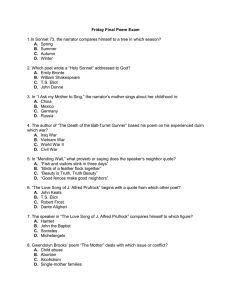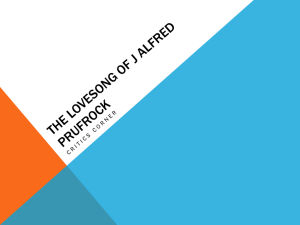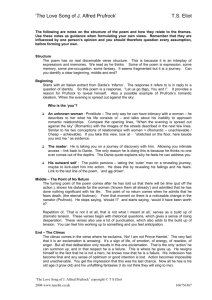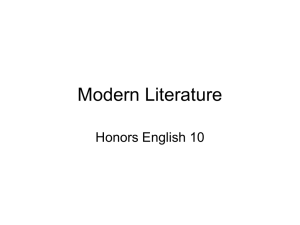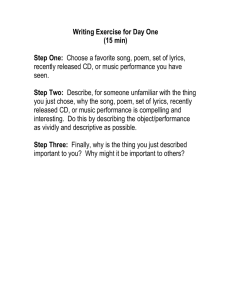Magnus Gustafsson, Chalmers University of Technology
advertisement
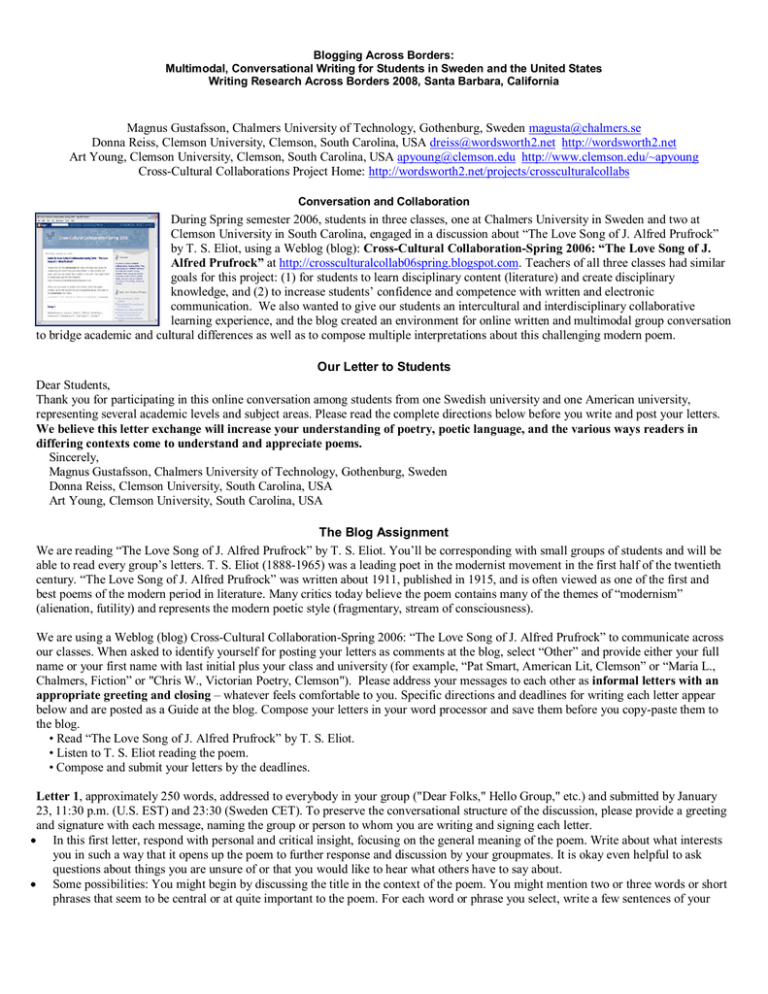
Blogging Across Borders: Multimodal, Conversational Writing for Students in Sweden and the United States Writing Research Across Borders 2008, Santa Barbara, California Magnus Gustafsson, Chalmers University of Technology, Gothenburg, Sweden magusta@chalmers.se Donna Reiss, Clemson University, Clemson, South Carolina, USA dreiss@wordsworth2.net http://wordsworth2.net Art Young, Clemson University, Clemson, South Carolina, USA apyoung@clemson.edu http://www.clemson.edu/~apyoung Cross-Cultural Collaborations Project Home: http://wordsworth2.net/projects/crossculturalcollabs Conversation and Collaboration During Spring semester 2006, students in three classes, one at Chalmers University in Sweden and two at Clemson University in South Carolina, engaged in a discussion about “The Love Song of J. Alfred Prufrock” by T. S. Eliot, using a Weblog (blog): Cross-Cultural Collaboration-Spring 2006: “The Love Song of J. Alfred Prufrock” at http://crossculturalcollab06spring.blogspot.com. Teachers of all three classes had similar goals for this project: (1) for students to learn disciplinary content (literature) and create disciplinary knowledge, and (2) to increase students’ confidence and competence with written and electronic communication. We also wanted to give our students an intercultural and interdisciplinary collaborative learning experience, and the blog created an environment for online written and multimodal group conversation to bridge academic and cultural differences as well as to compose multiple interpretations about this challenging modern poem. Our Letter to Students Dear Students, Thank you for participating in this online conversation among students from one Swedish university and one American university, representing several academic levels and subject areas. Please read the complete directions below before you write and post your letters. We believe this letter exchange will increase your understanding of poetry, poetic language, and the various ways readers in differing contexts come to understand and appreciate poems. Sincerely, Magnus Gustafsson, Chalmers University of Technology, Gothenburg, Sweden Donna Reiss, Clemson University, South Carolina, USA Art Young, Clemson University, South Carolina, USA The Blog Assignment We are reading “The Love Song of J. Alfred Prufrock” by T. S. Eliot. You’ll be corresponding with small groups of students and will be able to read every group’s letters. T. S. Eliot (1888-1965) was a leading poet in the modernist movement in the first half of the twentieth century. “The Love Song of J. Alfred Prufrock” was written about 1911, published in 1915, and is often viewed as one of the first and best poems of the modern period in literature. Many critics today believe the poem contains many of the themes of “modernism” (alienation, futility) and represents the modern poetic style (fragmentary, stream of consciousness). We are using a Weblog (blog) Cross-Cultural Collaboration-Spring 2006: “The Love Song of J. Alfred Prufrock” to communicate across our classes. When asked to identify yourself for posting your letters as comments at the blog, select “Other” and provide either your full name or your first name with last initial plus your class and university (for example, “Pat Smart, American Lit, Clemson” or “Maria L., Chalmers, Fiction” or "Chris W., Victorian Poetry, Clemson"). Please address your messages to each other as informal letters with an appropriate greeting and closing – whatever feels comfortable to you. Specific directions and deadlines for writing each letter appear below and are posted as a Guide at the blog. Compose your letters in your word processor and save them before you copy-paste them to the blog. • Read “The Love Song of J. Alfred Prufrock” by T. S. Eliot. • Listen to T. S. Eliot reading the poem. • Compose and submit your letters by the deadlines. Letter 1, approximately 250 words, addressed to everybody in your group ("Dear Folks," Hello Group," etc.) and submitted by January 23, 11:30 p.m. (U.S. EST) and 23:30 (Sweden CET). To preserve the conversational structure of the discussion, please provide a greeting and signature with each message, naming the group or person to whom you are writing and signing each letter. • In this first letter, respond with personal and critical insight, focusing on the general meaning of the poem. Write about what interests you in such a way that it opens up the poem to further response and discussion by your groupmates. It is okay even helpful to ask questions about things you are unsure of or that you would like to hear what others have to say about. • Some possibilities: You might begin by discussing the title in the context of the poem. You might mention two or three words or short phrases that seem to be central or at quite important to the poem. For each word or phrase you select, write a few sentences of your • own referring back to the poem in order to explain why you think they are important. You might even want to look them up in a good dictionary to further your understanding of how poetic language works. Include within your letter one or two sentences to introduce yourself to the group, for example, your name, which class you are taking, which university, and your academic interest or emphasis. You can say something about your previous experience with poetry as well, if you like. Letter 2, approximately 250 words, addressed to everybody in the group and submitted by January 26, 11:30 p.m. (U.S. EST) …. • Before you compose your Letter 2, read all the Letter 1 submissions and any second letters already posted by members of your group. In your Letter 2, addressed to your entire group, refer specifically to at least two members of the group by name, attempting to cite at least two groupmates whose Letter 1 submissions have not already been cited by others if possible. Please respond to at least one person not in your class. • In your Letter 2, identify and explain how one or more keywords and reflective comments by groupmates contributed to your understanding of the poem. Comment on ways in which their interpretations are similar to and/or different from your own. This response can also be personal, connecting your own understanding and experience with what you learned from reading the poem and from your group. Don’t hesitate to quote briefly from your groupmates’ letters and from the poem. Letter 3, approximately 250 words, addressed to everybody in the group and submitted by January 30, 11:30 p.m. (U.S. EST) …. 1. First, read the second letters and any additional letters already posted by members of your group. Compose a personal response about some of the ideas and opinions presented there, citing by name at least two groupmates whose Letter 2 submissions have not already been cited by others if possible. Please respond to at least one person not in your same class. 2. Second, either create or find another representation of the theme or mood of “The Love Song of J. Alfred Prufrock,” for example, an illustration or music or another poem. You will need to locate or post this additional representation online so your partners can access it on the Web. 3. Third, explain fully the relationship between the representation you have selected or composed and your understanding of The Love Song of J. Alfred Prufrock. Excerpts from “The Love Song of J. Alfred Prufrock” T.S. Eliot (1888–1965). Prufrock and Other Observations. 1917. http://www.bartleby.com/198/1.html LET us go then, you and I, When the evening is spread out against the sky Like a patient etherised upon a table; Let us go, through certain half-deserted streets, The muttering retreats 5 Of restless nights in one-night cheap hotels And sawdust restaurants with oyster-shells: Streets that follow like a tedious argument Of insidious intent To lead you to an overwhelming question … Oh, do not ask, “What is it?” Let us go and make our visit. In the room the women come and go Talking of Michelangelo. ……………………….. 10 In the room the women come and go Talking of Michelangelo. ……………………….. And indeed there will be time For the yellow smoke that slides along the street, Rubbing its back upon the window-panes; 25 There will be time, there will be time To prepare a face to meet the faces that you meet; There will be time to murder and create, And time for all the works and days of hands That lift and drop a question on your plate; 30 Time for you and time for me, And time yet for a hundred indecisions, And for a hundred visions and revisions, Before the taking of a toast and tea. 35 Do I dare 45 Disturb the universe? In a minute there is time For decisions and revisions which a minute will reverse. ………………………… I grow old … I grow old … 120 I shall wear the bottoms of my trousers rolled. Shall I part my hair behind? Do I dare to eat a peach? I shall wear white flannel trousers, and walk upon the beach. I have heard the mermaids singing, each to each. I do not think that they will sing to me. 125 I have seen them riding seaward on the waves Combing the white hair of the waves blown back When the wind blows the water white and black. We have lingered in the chambers of the sea By sea-girls wreathed with seaweed red and brown Till human voices wake us, and we drown.
